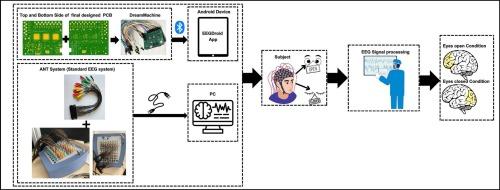增强移动EEG: DreamMachine的软件开发和性能洞察
IF 2.1
Q3 ENGINEERING, ELECTRICAL & ELECTRONIC
引用次数: 0
摘要
脑电图(EEG)广泛应用于神经学、认知神经科学、睡眠研究和心理健康等领域。它记录脑电活动来研究神经生理功能。许多脑电图和移动脑电图系统是可用的。然而,遵守国际临床神经生理学联合会(IFCN)制定的标准对于确保临床环境中高质量的数据收集至关重要。DreamMachine是一种移动脑电图设备,完全符合这些标准,提供250 Hz的24通道记录,低功耗蓝牙(BLE),以及眼电图(EOG)和心电图(ECG)功能。它的低成本使其成为脑电图研究的一个可行选择。本文详细介绍了开源DreamMachine的软件体系结构。重点放在数据压缩和设备与配套的Android应用程序之间的通信。研究了Android应用程序的功能细节,包括增益设置、每通道位、滤波器、位移位和安全系数。随后,通过标准的睁眼/闭眼实验来评估系统的性能,并将其结果与实验室脑电图系统进行比较,以评估DreamMachine系统的性能。本文章由计算机程序翻译,如有差异,请以英文原文为准。

Enhancing mobile EEG: Software development and performance insights of the DreamMachine
Electroencephalography (EEG) is widely used in fields such as neurology, cognitive neuroscience, sleep research, and mental health. It records brain electrical activity to study neurophysiological functions. Numerous EEG and mobile EEG systems are available. However, adherence to the standards set by the International Federation of Clinical Neurophysiology (IFCN) is essential for ensuring high-quality data collection in clinical environments. The DreamMachine, a mobile EEG device, complies fully with these standards, offering 24-channel recordings at 250 Hz, Bluetooth Low Energy (BLE), and capabilities for electrooculography (EOG) and electrocardiography (ECG). Its low cost makes it an accessible option for EEG studies. The software architecture of the open-source DreamMachine is detailed in this study. Focus is placed on data compression and communication between the device and its companion Android application. The details of the Android application’s features, including gain settings, bits per channel, filters, bit-shifting, and safety factors, are investigated. Subsequently, the system’s performance is evaluated through a standard eyes-open/eyes-closed experiment, comparing its results with a laboratory EEG system across a significant number of participants to assess the performance of the DreamMachine system.
求助全文
通过发布文献求助,成功后即可免费获取论文全文。
去求助
来源期刊

HardwareX
Engineering-Industrial and Manufacturing Engineering
CiteScore
4.10
自引率
18.20%
发文量
124
审稿时长
24 weeks
期刊介绍:
HardwareX is an open access journal established to promote free and open source designing, building and customizing of scientific infrastructure (hardware). HardwareX aims to recognize researchers for the time and effort in developing scientific infrastructure while providing end-users with sufficient information to replicate and validate the advances presented. HardwareX is open to input from all scientific, technological and medical disciplines. Scientific infrastructure will be interpreted in the broadest sense. Including hardware modifications to existing infrastructure, sensors and tools that perform measurements and other functions outside of the traditional lab setting (such as wearables, air/water quality sensors, and low cost alternatives to existing tools), and the creation of wholly new tools for either standard or novel laboratory tasks. Authors are encouraged to submit hardware developments that address all aspects of science, not only the final measurement, for example, enhancements in sample preparation and handling, user safety, and quality control. The use of distributed digital manufacturing strategies (e.g. 3-D printing) is encouraged. All designs must be submitted under an open hardware license.
 求助内容:
求助内容: 应助结果提醒方式:
应助结果提醒方式:


